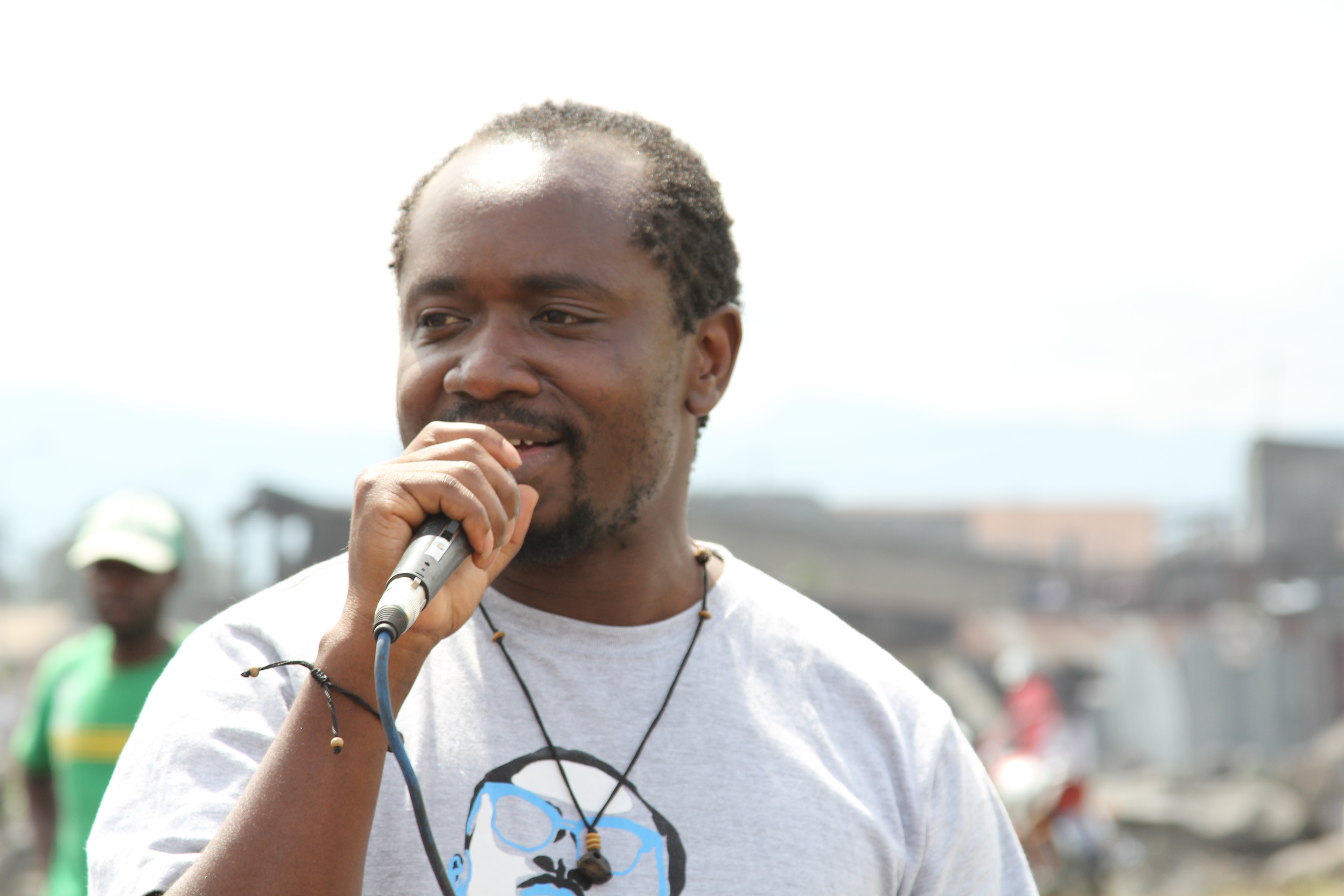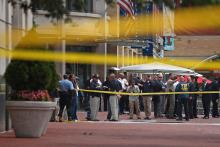Peace and Nonviolence

As international concern about U.S. targeted killings with drones rises, Ben Emmerson, UN Special Rapporteur on Human Rights and Counter-Terrorism, said Sunday that every drone strike should be impartially investigated. According to Common Dreams,
"Emmerson is preparing a report for the next session of the Human Rights Council in March covering the use of drone attacks, which have spiked since Obama's presidency.
He questioned the legality of the drone strikes and noted the growing global outrage over their use. ‘We can't make a decision on whether it is lawful or unlawful if we do not have the data. The recommendation I have made is that users of targeted killing technology should be required to subject themselves, in the case of each and every death, to impartial investigation. If they do not establish a mechanism to do so, it will be my recommendation that the UN should put the mechanisms in place through the Human Rights Council, the General Assembly and the Office of the High Commissioner.’”
This comes as a flurry of drone strikes along the Pakistan-Afghanistan border in the last four days have killed at least 18 people. Reuters reports that six people were killed in an attack on Saturday, five early on Sunday, and two more later on Sunday near the location of the previous strike. These attacks came as celebrations of the Eid al-Fitr festival, marking the end of Ramadan, were occurring. Tuesday, a further strike killed five, according to the Associated Press.
Mr. Emmerson’s call for investigations is an important step, one that will hopefully mark the beginning of the end for drones as killing machines.
“There is no way to peace along the way to safety. For peace must be dared. It is the great venture.” — German pastor and theologian Dietrich Bonhoeffer (1906-1945)
In Goma, the epicenter of Congo mayhem, where corruption and poverty thrive, Fidel Bafilemba embodies the courage to challenge the norm of his home country.
“That’s me—the disorder of this country, but also the hope for a better future. A hope for an educated people. That’s me. Fidel Bafilemba, activist.”
Working for peace in his hometown has been a journey of transformation—Fidel is a militia member turned peace activist. In the midst of chaos, Fidel manifests hope—a hope for a better future where he, his family, and his community can make self-determined decisions for prosperity and reconciliation.
His struggle is to bring to fruition God’s “kingdom come,” even amid the mayhem of his environment, “for the kingdom of God depends not on talk but on power.” (1 Cor. 4:20).
When others see destruction, poverty, and war, Fidel envisions the future of his people. It is a future of a Congo lush with natural resources and beauty that benefits, rather than destroys, communities. That’s why Fidel refuses to accept impunity and injustice, and seeks to empower others to question and ask, “why?”
“Why don’t we have roads? Why don’t we have education? Why don’t we have, why don’t we have?”

When I was in junior high, I attended a private Christian school where my youth pastor used to show us videos of Christians in public schools being arrested for praying at the flagpole, as well as future Christians being executed because of “liberals who want to take away our right to worship.”
So I get it. When a guy walks up to a conservative Christian organization’s headquarters and starts shooting, it confirms what many people already believe: Evangelical Christians in America are a persecuted minority; and the people behind the persecution are groups like the Southern Poverty Law Center, a group that labels anyone who “takes a stand for Biblical righteousness” a hate group. The storyline would sound reasonable if it weren’t for one small problem: It’s completely ridiculous.

Following attacks on seven U.S. mosques in the last two weeks, including three attacks last weekend, many Muslim Americans are approaching the end of Ramadan on Aug. 19 under a cloud of fear as Muslim groups try to increase security without spurring panic.
According to reports, vandals shot paintballs at the Grand Mosque of Oklahoma City on Aug. 12, and in Lombard, Ill., someone threw a bottle filled with acid at an Islamic school while 500 people prayed inside. The night before, a neighbor fired an air rifle at the Muslim Education Center in Morton Grove, Ill., while on Aug. 7, two women were videotaped throwing pig legs on a proposed mosque site in Ontario, Calif.
“Peace for humanity is not only the absence of war, or the end of violence ... For us Christians, peace is based on a fundamental new relationship between mankind and God. That is why Christ said he brought peace, ‘not as the world gives.’ He brought a different peace.” – Bishop Samuel Ruiz García, known as Don Samuel, a champion of the poor and of the indigenous people in southern Mexico
Eastern Congo is home to some of the world’s most stunning scenery—and some of its most brutal and unimaginable violence. The relationship between these two symbols of the region is a close one.
Part of the call of Christian peacemakers is not only to make peace between people a reality, but also to bring peace between people and the planet. In his work, conservationist Dominique Bikaba recognizes that peace between people and peace with our environment are closely intertwined, and he is seeking to bring about both.
Armed groups are waging war in eastern Congo, taking no heed of the grave impact that the conflict is having on the environment around them. The resources of the region are being exploited, to the detriment of future generations. This disregard for the communities of the region is a modern-day salting of the land. It’s a practice well known to the people of Israel in the Old Testament, in which armies would spread salt on the land of their adversaries so that nothing would grow there (see Judges 9:45).
The conflict in Congo is being waged on local communities—but Dominique is a problem-solver. He is seeking creative ways to conserve these communities while conserving the environment they inhabit, fostering the inherent relationship between the two. He is “bringing the forest to the community.”


“The practice of peace and reconciliation is one of the most vital and artistic of human actions.” — Vietnamese Buddhist monk Thich Nhat Hanh
How do you combat violence, institutionalized rape, a corrupt government, and years of injustice? With more violence, better weapons, or more strategic strikes?
For Petna Ndaliko, you do it through art. In spite of attempts by the Congolese government and militia groups to silence them, Petna created a stage for local youth to express themselves. They sing about oppression, about corruption, and about the people’s ability to overcome.
Art heals. It unites a community. And it can ignite a spark for change. Film can inspire rape survivors to find their voices and tell their stories. From a grassroots level, music moves people to action.
Petna calls himself a small light from which a huge fire starts growing. For many Christians, this echoes Matthew 5:14, “You are the light of the world. A city built on a hill cannot be hidden.”
Petna’s hope is for the flame to spread through the youth of Congo, to carry the message of hope forward to future generations, finding creative ways to combat injustice.
“It isn’t enough to talk about peace. One must believe in it. And it isn’t enough to believe in it. One must work at it.” –Eleanor Roosevelt, First Lady of the United States from 1933-45
“If we just sat with crossed arms, what would happen then?” is the question Denise, a Congolese civil rights attorney, asks us.
She has seen the destruction of her home through natural disaster and the pain of thousands of Congolese women who are raped every year. Still, she is faithful with the calling that she has been given—working to prosecute the cases she can to help rape survivors seek justice and find the hope to continue on.
Denise knows that to make peace, it is necessary to restrain and often punish the evil that humans do to one another.
“The Bible takes evil seriously and clearly says that evildoers should be held accountable for their deeds, and that the state has the legitimate role of bringing to justice those who perpetrate terrible crimes,” writes Jim Wallis in a July 2011 Sojourners’ column, “The Things That Make For Peace.”
But Denise’s work does not focus just on the punishment of those who commit rape but on the restoration of the survivors.
“Ultimately, we have just one moral duty: to reclaim large areas of peace in ourselves, more and more peace, and to reflect it toward others. And the more peace there is in us, the more peace there will also be in our troubled world.” – Etty Hillesum, Dutch diarist who died at Auschwitz
The social fabric that wove together Amani’s moral values and passion for peace is the target of rebel groups that destabilize and destroy communities. Amani grew up playing football and attending school and church in an area that has been chronically unstable for the past 16 years.
Despite the threat, Amani learned within his local structures the power of community in overcoming insecurity—the hub for gaining moral and intellectual values “to make every effort to come together and live as a community.”
Congo is still suffering from the overspill of the Rwandan genocide, the aftermath of which took the lives of both of Amani’s parents. Rebel groups roam the Kivu provinces of eastern Congo and seek to unravel the very social fabric of Amani’s community.
Taking heart from the moral lessons he gained from playing football with his school and through his education, Amani decided to overcome the insecurity caused but he rebels by bringing people together by providing a peace market—a community nucleus for women, children, and men to gather in a safe, empowered, and peaceful environment to care for one another.

As drones continue to proliferate, the technology is behind them is speeding ahead. Wired takes a look at the next generation of drones now in development.
"Today's unmanned robotic planes only seemadvanced. A decade after the CIA and the Air Force tucked a Hellfire missile under the wing of a Predator drone, much hasn't actually changed: pilots in air-conditioned boxes remotely control much of the armed drone fleet; the robo-planes are easy for an enemy to spot; the weapons they fire weigh about the same; as much as they love the skies, they take refuge on dry land; and they're built around traditional airframes like planes and helicopters. Yawn.
Drones are moving out to sea -- above it and below it. They're growing increasingly autonomous, no longer reliant on a pilot with a joystick staring at video feeds from their cameras. They're getting stealthier; the payloads they carry are changing; and they're going global. They're pushing humans out of the gondolas of blimps. And the laboratories of the drones of the future aren't only owned by American defense contractors, they're in Israel and China and elsewhere, too. … Here's a look at the more ambitious ways drones are getting re-imagined."

Another senseless act of violence today was targeted at the Family Research Council. A security guard is now in stable condition at a local hospital after being shot in the arm by a 28-year-old assailant. The suspect is now in custody. Multiple outlets are reporting that the young man specifically intended to attack FRC staff because of their conservative advocacy.
My prayers goes out to the security guard and his family as he recovers. His actions may have saved the lives of many. Washington, D.C., Police Chief Cathy Lanier said, “The security guard here is a hero, as far as I’m concerned.”
My heart is with the rest of the FRC staff. Their place of work will not feel safe after this. It will undoubtedly be difficult knowing there are those who would do violence against you because of your convictions.

Efforts to bring the rule of law to killing are not always easy or clear cut. Although as an advocate of non-violence, I can condemn all killing; whether killing in a conflict is “legal” or not depends on the circumstances in which it occurs. International law does not prohibit all taking of life.
Mary Ellen O'Connell, a law professor and research professor of international dispute resolution at the Kroc Institute for International Peace Studies at the University of Notre Dame, is a specialist on the international law of armed conflict. In a column on CNN, she explains that under international law, killing enemy fighters during an armed conflict – a war – is legal. Outside of war, it generally is not, the human right of life prevails. Although this “dual standard for justifiable killing makes the law protecting the right to life more complicated,” it is how international law assesses violent conflicts.

One of the primary criticisms of using drones to kill high-level al Qaeda or Taliban leaders is that they are extra-judicial executions, and that a policy of capturing these militants and putting them on trial would be preferable. In addition, if they were captured, useful intelligence could be gathered. The rejoinder, of course, is how is it possible to capture people living in the remote tribal areas of Pakistan or Yemen?
It appears that the technology to answer that question may soon be available. Greg McNeal speculates in Forbes, with a scenario adapted from the Lawfare blog. Someday soon, a drone could launch a non-lethal weapon – something that stuns a person, perhaps a taser – lower a robot to the ground to retrieve the person, then return to the aircraft that returns to its base with the captured prisoner.
McNeal concludes, “Regardless of how you do it, it seems like technology is not the biggest hurdle in developing and perfecting drones that can capture rather than kill.”

While most of our attention is focused on the use of armed drones attacking suspected militants in Pakistan, Yemen, and Somalia, unarmed surveillance drones are taking to the skies across America, as the Toronto Star recently reported. The first known case of a drone assisting in an arrest occurred last year in North Dakota.
“Amid hundreds of hectares of corn and soybeans, far from the closest town, a Predator drone led to the arrests last year of farmer Rodney Brossart and five members of his family. The drone was called in after a dispute over a neighbour’s six lost cows escalated into a 16-hour standoff with police. It is one of the first reported cases where an unmanned drone assisted in the arrest of a U.S. citizen on his own property. It was also a controversial sign of how drones — in all shapes and sizes — are beginning to hover over American skies.”
And, far from being an aberration, drones at home are proliferating.
“But the federal government has been quietly expanding their use. Even as the wars abroad wind to an end, the military has been pleading for funding for more pilots. Drones cannot be flown now in the United States without FAA approval. But with little public scrutiny, the FAA already has issued at least 266 active testing permits for domestic drone operations, amid safety concerns. … While drone use in the rest of the United States has been largely theoretical, in eastern North Dakota it is becoming a way of life.”
Minnesota Public Radio also takes a look at the North Dakota scene, reporting on a drone research project at the University of North Dakota that is about to launch a program that would give sheriffs in 16 North Dakota counties access to two, and perhaps four, drones.
“With law enforcement budgets shrinking, technology is playing a greater role in policing. And for agencies that want air coverage, a camera-equipped drone, at a cost of around $50,000, can be a cheaper alternative to owning and operating a piloted airplane or helicopter. Minnesota law enforcement officials have expressed some interest, but without question, North Dakota is where the action is.”

David Axe, in Wired, examines America’s secret drone war in Africa.
“More secret bases. More and better unmanned warplanes. More frequent and deadly robotic attacks. Some five years after a U.S. Predator Unmanned Aerial Vehicle flew the type’s first mission over lawless Somalia, the shadowy American-led drone campaign in the Horn of Africa is targeting Islamic militants more ruthlessly than ever. … It’s part of a broader campaign of jet bombing runs, naval gun bombardment, cruise-missile attacks, raids by Special Operations Forces and assistance to regional armies such as Uganda’s.”
While Predator and Reaper drones are currently in use, the next generation is already underway. The Northrop Grumman corporation and the U.S. Navy are testing what is known as the X-47B, a drone capable of taking off from and landing on aircraft carriers. From Business Insider, here’s an animated promotional video from Grumman showing what its new drone can do. As a pair of the aircraft take off, swoop over deserts and mountains, firing missiles at targets on the ground; they look like bats from hell.

In the news today are two stories of drone victims seeking justice for relatives who have been killed or injured.
The Guardian reports on legal action being taken in the U.K. by an Afghan man who lost five relatives in a missile strike. A letter sent to the Ministry of Defense is demanding details of Britain's role in supplying information to the American military "kill list," including “the compilation, review and execution of the list and what form it takes." Habib Rahman, a bank worker in Kabul, lost two brothers, two uncles and his father-in-law in an alleged case of mistaken identity resulting in a U.S. missile attack on their cars on 2 September 2010.
And in Pakistan’s Dawn, Waris Husain, a Washington, D.C., based attorney and writer for the newspaper, examines the U.S. failure to compensate Pakistanis who suffer property loss or physical injury due to drone missions. While some survivors of civilian casualties in Iraq and Afghanistan have received payments, none have gone to victims of drone attacks in Pakistan, and no U.S. court has accepted a claim by Pakistani civilians. Mr. Husain concludes: “While the US wishes to stabilise its relationship with Pakistan, the CIA shows no signs of minimising it use of drone strikes in Pakistan’s border region, which means a system of compensation for victims is absolutely necessary.”

German author and journalist, Dirk Kurbjuweit, in an essay in DER SPIEGEL,reports that the German military is considering whether it should buy armed drones. Given that “Germany is relatively scrupulous in matters of war,” he writes, “the unmanned aircraft seems to be the ideal weapon for the country.” But he then notes the questions that raises in regard to pride, humanity and the law, and argues that so-called “humane” drones are, in fact, the most brutal of weapons.
The fundamental question is an ongoing discussion over “whether humane weapons are even feasible. In other words, is it possible to create weapons that somehow protect perpetrators or lessen the damage to victims? In this context, the word humane is not an absolute but a relative concept, referring to a weapon that is less horrific than other weapons.”
One of the arguments for humaneness is the precision of the missiles, that they do not destroy as much of the area surrounding their target and thus produce fewer civilian casualties than bombing attacks from aircraft. They also pose no risk to the force using them, further reducing the casualties of war. On the other hand, their relative humaneness makes their use more likely; and the targeted executions of alleged terrorists are dubious under international law.
Kurbjuweit concludes:
“A humane approach to war is a complex issue. Drones seem relatively humane, but that perception only increases the temptation to use them. They spare one's own troops, which is good, but they pose a great threat to civilians, which is terrible. As a result, the humane approach gives rise to a special form of inhumanity. …
But no one should allow themselves to be seduced by the idea that this weapon is humane or good. A drone armed with missiles exposes the essential nature of war in an especially clear way. Because a drone hunts down an individual, the slaughter loses its anonymity. The victim acquires a name and a face, and it becomes abundantly clear what war is all about: the destruction of human beings.”

In a speech yesterday in Washington, administration counter-terrorism advisor John Brennan defended the campaign of drone strikes in Yemen. As reported in the Los Angeles Times:
“In his most explicit comments on Washington's largely hidden military and intelligence operations in Yemen, John Brennan said no evidence indicates that the drone strikes are helping recruit members for Al Qaeda in the Arabian Peninsula, or AQAP, the Yemen-based group that is Al Qaeda's most active branch. ...
"Brennan said that the drone pilots, who operate the aircraft from remote ground stations, make every effort to avoid civilian casualties. 'And contrary to conventional wisdom, we see little evidence that these actions are generating widespread anti-American sentiment or recruits for AQAP. ... In short, targeted strikes against the most senior and most dangerous AQAP terrorists are not the problem, they are part of the solution.' "
Addressing a common concern, Brennan said that the only targets for drones are militants whose goal is to attack the US or its allies, not those fighting against the Yemeni government. He added that U.S. officials do provide intelligence information to Yemeni armed forces fighting against militants.
The report noted that the drone attacks are part of a larger strategy.
“U.S. special operations forces have been advising Yemeni military units, and Washington is providing $337 million in aid to Yemen this year, the largest American aid package ever disbursed to the impoverished nation.”
In an op-ed for The New York Times, Nick Kristof asks how the United States should be tackling the conflict in Syria:
President Obama’s finest moments in foreign policy, like the Osama bin Laden raid or the Libya intervention, resulted from close engagement and calculated risks.
His lapses come when he’s passive or AWOL — as in Syria. I’m generally a fan of Obama’s foreign policy, but on Syria there’s a growing puzzlement around the world that he seems stuck behind the curve.
The United States shouldn’t invade Syria. But we should work with allies to supply weapons, training and intelligence to rebels who pass our vetting.
Learn more here

I wasn’t sure what to expect as we pulled into the parking lot of a local Sikh temple — or gurudwara— last night, but I assumed it would be culturally enlightening and offer a glimpse into a worldview and religious tradition I have only sparingly engaged. While yesterday was the National Day of Remembrance and Solidarity for the victims and mourners of the shooting in Wisconsin, I felt deeply compelled to stand with them in their pain as a follower of the Prince of Peace.
Walking into the gurudwara's courtyard holding my two-year-old daughter’s hand, my wife and two friends were immediately greeted by the priest with a handshake and smile. He thanked us for coming and invited us into the experience that included a short service in the gurudwara and vigil outside to remember the six worshipers who were shot by a man that had never met them. I can only speculate, but if this man would have engaged these people on a relational level at any point, he certainly would have reconsidered his actions.
Much like the response of the Amish after the horrific schoolhouse massacre in 2006, the Sikh community has intentionally chosen to respond to by offering radical love and forgiveness. Although somber, they carried a deep conviction to embrace the way of peace as retaliation for the death of these innocent victims.